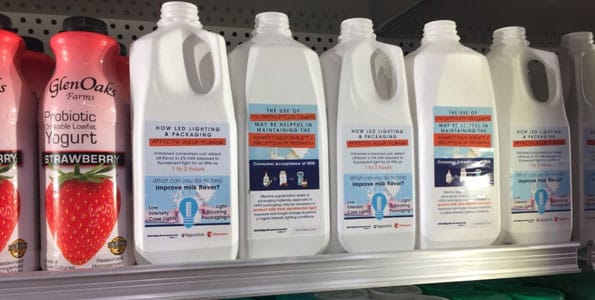Milk Flavor Profile Influenced by Retail Lighting and Packaging

If you’ve ever tasted fresh milk with its creamy, slightly sweet flavor, you know how delicious good milk can be. You probably also noted the brand and the grocery store from which it came. Likewise, you may have experienced milk that tasted off or gone bad — perhaps with hints of burnt, plastic or cardboard flavors. These off-flavor notes are caused by oxidation in the milk which is caused by light exposure.
As part of its ongoing commitment to fresh marketing, Hillphoenix sponsored two studies, conducted by researchers at the Virginia Tech Food Science Department, Chemours Packaging, and the Dairy Research Institute, to investigate the effects of fluorescent and LED lighting under retail storage conditions on consumer acceptance of the flavor of milk.
Milk consumption in the United States has been decreasing for decades, declining 5.2% in 2015 alone — but for what reason? One probable cause is increasing competition with alternative plant-based milk beverages. The trend may also be partly due to consumer experiences with fresh milk containing off-flavors and lower nutrient quality due to light-induced oxidation reactions. Research has long established that exposure to fluorescent light in the retail case generates a variety of volatile compounds that overwhelm fresh milk’s familiar sweet, mild flavor and clean, pleasing aftertaste. The vitamins, lipids, and proteins in milk are also affected by these oxidation reactions. A 2002 study found that untrained consumers can detect off-flavor in 2% milk exposed to fluorescent light for as little as one to two hours.
Many retailers are switching from fluorescent lights to more energy-efficient light-emitting diode (LED) lights to meet US Department of Energy-mandated energy reduction requirements. Milk oxidation under LED light is a new area of research and the primary subject of the Hillphoenix studies. Both studies applied various levels of light blocking additives and technology to two different types of packaging, under different light intensities and refrigerated retail case types. The first evaluated milk stored in various types of high-density polyethylene (HDPE); in the second, the containers were composed of polyethylene terephthalate (PET).
The overall average acceptability of milk ranged from “like slightly” to “like moderately” on the hedonic scale, which is a very significant difference. Milk in both types of packages had comparable overall acceptability scores when exposed to LED light. LED also diminished the aftertaste of milk packaged in translucent HDPE without extra light barriers. Fluorescent light significantly diminished overall acceptability, especially of milk in translucent HDPE and clear PET packaging. Changes in dissolved oxygen content, as an indication of oxidation, supported the observed differences in consumer acceptance of milk stored under fluorescent and LED light.
Consumers like the flavor of fresh milk, and retailers can protect it by selecting the appropriate combination of packaging, store and refrigerated retail case lighting to block detrimental light wavelengths.